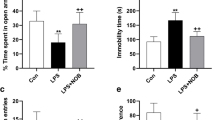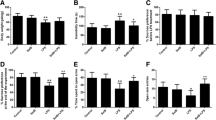Abstract
Injury associated with neuroinflammation has been linked with several kinds of neurodegenerative diseases. The activation of the NLRP3 inflammasome plays an important role in microglia-mediated inflammation. Phoenixin (PNX)-20 is a newly discovered neuropeptide with pleiotropic effects involved in the regulation of reproductive and cognitive function, depression, and food uptake. This study investigated whether PNX-20 possesses a protective effect against lipopolysaccharide (LPS)-induced activation of the NLRP3 inflammasome in microglia. Firstly, our results show that the PNX-20 treatment significantly prevented LPS-induced expression of NADPH oxidase 4 (NOX-4) and the generation of reactive oxygen species (ROS). Secondly, PNX-20 mitigated LPS-induced upregulation of TxNIP, an upstream regulator of NLRP3 inflammasome activation. Thirdly, further evaluation of the major components of the NLRP3 inflammasome revealed that PNX-20 inhibited LPS-mediated upregulation of NLRP3, ASC, and cleaved caspase-1 (P10). Notably, based on our results, the inhibitory effect of PNX-20 on the NLRP3 inflammasome results in the inhibition of IL-1β and IL-18 secretions. Finally, we found that PNX-20 ameliorated the reduction in SIRT1 expression induced by LPS. When microglial SIRT1 was inhibited by nicotine, PNX-20 lost its suppressive effect on the expression of NLRP3, ASC, and caspase-1, as well as the secretion of IL-1β and IL-18. As a result of these findings, we draw the conclusion that the neuroprotective effect of PNX-20 is dependent on SIRT1. Collectively, the study shows that PNX-20 has a regulatory effect via modulation of neuroinflammation.








Similar content being viewed by others
References
Amor S, Puentes F, Baker D, van der Valk P (2010) Inflammation in neurodegenerative diseases. Immunology 129(2):154–169
Batista CRA, Gomes GF, Candelario-Jalil E, Fiebich BL, de Oliveira ACP (2019) Lipopolysaccharide-induced neuroinflammation as a bridge to understand neurodegeneration. Int J Mol Sci 20(9):2293
Catorce MN, Gevorkian G (2016) LPS-induced murine neuroinflammation model: main features and suitability for pre-clinical assessment of nutraceuticals. Curr Neuropharmacol 14(2):155–164
Chen WW, Zhang X, Huang WJ (2016) Role of neuroinflammation in neurodegenerative diseases. Mol Med Rep 13(4):3391–3396
Fiebich BL, Batista CRA, Saliba SW, Yousif NM, de Oliveira ACP (2018) Role of microglia TLRs in neurodegeneration. Front Cell Neurosci 12:329
Gustin A, Kirchmeyer M, Koncina E, Felten P, Losciuto S, Heurtaux T, Tardivel A, Heuschling P, Dostert C (2015) NLRP3 inflammasome is expressed and functionalin mouse brain microglia but not in astrocytes. PLoS One 10(6):e0130624
He Y, Hara H, Núñez G (2016) Mechanism and regulation of NLRP3 inflammasome activation. Trends Biochem Sci 41(12):1012–1021
Henn A, Lund S, Hedtjärn M, Schrattenholz A, Pörzgen P, Leist M (2009) The suitability of BV2 cells as alternative model system for primary microglia cultures or for animal experiments examining brain inflammation. ALTEX 26(2):83–94
Ishrat T, Mohamed IN, Pillai B, Soliman S, Fouda AY, Ergul A, El-Remessy AB, Fagan SC (2015) Thioredoxin-interacting protein: a novel target for neuroprotection in experimental thromboembolic stroke in mice. Mol Neurobiol 51(2):766–778
Kacimi R, Giffard RG, Yenari MA (2011) Endotoxin-activated microglia injure brain derived endothelial cells via NF-κB, JAK-STAT and JNK stress kinase \ pathways. J Inflamm (Lond) 8:7
Lawson LJ, Perry VH, Dri P, Gordon S (1990) Heterogeneity in the distribution and morphology of microglia in the normal adult mouse brain. Neuroscience 39(1):151–170
Lehnardt S, Lachance C, Patrizi S, Lefebvre S, Follett PL, Jensen FE, Rosenberg PA, Volpe JJ, Vartanian T (2002) The toll-like receptor TLR4 is necessary for lipopolysaccharide-induced oligodendrocyte injury in the CNS. J Neurosci 22:2478–2486
Li Y, Yang X, He Y, Wang W, Zhang J, Zhang W, **g T, Wang B, Lin R (2017) Negative regulation of NLRP3 inflammasome by SIRT1 in vascular endothelial cells. Immunobiology 222(3):552–561
Ma Q, Chen S, Hu Q, Feng H, Zhang JH, Tang J (2014) NLRP3 inflammasome contributes to inflammation after intracerebral hemorrhage. Ann Neurol 75(2):209–219
MciLwraith EK, Belsham DD (2018) Phoenixin: uncovering its receptor, signaling and functions. Acta Pharmacol Sin 39(5):774–778
McIlwraith EK, Loganathan N, Belsham DD (2019) Regulation of Gpr173 expression, a putative phoenixin receptor, by saturated fatty acid palmitate and endocrinedisrupting chemical bisphenol A through a p38-mediated mechanism in immortalized hypothalamic neurons. Mol Cell Endocrinol 485:54–60
Nasoohi S, Ismael S, Ishrat T (2018) Thioredoxin-interacting protein (TXNIP) in cerebrovascular and neurodegenerative diseases: regulation and implication. Mol Neurobiol 55(10):7900–7920
Pałasz A, Janas-Kozik M, Borrow A, Arias-Carrión O, Worthington JJ (2018) The potential role of the novel hypothalamic neuropeptides nesfatin-1, phoenixin, spexin \ and kisspeptin in the pathogenesis of anxiety and anorexia nervosa. Neurochem Int 113:120–136
Pang T, Wang J, Benicky J, Sánchez-Lemus E, Saavedra JM (2012) Telmisartan directly ameliorates the neuronal inflammatory response to IL-1β partly through the JNK/c-Jun and NADPH oxidase pathways. J Neuroinflammation 9:102
Sarkar S, Malovic E, Sarda D, Lawana V, Rokad D, ** H, Anantharam V, Kanthasamy A, Kanthasamy AG (2018) Characterization and comparative analysis of a new mouse microglial cell model for studying neuroinflammatory mechanisms during neurotoxic insults. Neurotoxicology 67:129–140
Song L, Pei L, Yao S, Wu Y, Shang Y (2017) NLRP3 inflammasome in neurological diseases, from functions to therapies. Front Cell Neurosci 11:63
Stansley B, Post J, Hensley K (2012) A comparative review of cell culture systems for the study of microglial biology in Alzheimer’s disease. J Neuroinflammation 9:115
Stein LM, Tullock CW, Mathews SK, Garcia-Galiano D, Elias CF, Samson WK, Yosten GL (2016) Hypothalamic action of phoenixin to control reproductive hormone secretion in females: importance of the orphan G protein-coupled receptor Gpr173. Am J Phys Regul Integr Comp Phys 311(3):R489–R496
Streit WJ, Kincaid-Colton CA (1995) The brain’s immune system. Sci Am 273:54–61
Suszka-Świtek A, Pałasz A, Filipczyk Ł, Menezes IC, Mordecka-Chamera K, Angelone T, Bogus K, Bacopoulou F, Worthington JJ, Wiaderkiewicz R (2019) The GnRH analogues affect novel neuropeptide SMIM20/phoenixin and GPR173 receptor expressions in the female rat hypothalamic-pituitary-gonadal (HPG) axis. Clin Exp Pharmacol Physiol 46(Jan 4):350–359
Velagapudi R, Lepiarz I, El-Bakoush A, Katola FO, Bhatia H, Fiebich BL, Olajide OA (2019) Induction of autophagy and activation of SIRT1 deacetylation mechanisms mediate neuroprotection by the pomegranate metabolite urolithin a in BV2 microglia and differentiated 3D human neural progenitor cells. Mol Nutr Food Res 63(10):e1801237
Wang M, Deng SP, Chen HP, Jiang DN, Tian CX, Yang W, Wu TL, Zhu CH, Zhang Y, Li GL (2018) Phoenixin participated in regulation of food intake and growth in spotted scat, Scatophagus argus. Comp Biochem Physiol B Biochem Mol Biol 226:36–44
Wong WT, Li LH, Rao YK, Yang SP, Cheng SM, Lin WY, Cheng CC, Chen A, Hua KF (2018) Repositioning of the beta-blocker carvedilol as a novel autophagy inducer that inhibits the NLRP3 inflammasome. Front Immunol 9:1920
Xavier AL, Menezes JR, Goldman SA, Nedergaard M (2014) Fine-tuning the central nervous system: microglial modelling of cells and synapses. Philos Trans R Soc Lond Ser B Biol Sci 369(1654):20130593
Yanai T, Kurosawa A, Nikaido Y, Nakajima N, Saito T, Osada H, Konno A, Hirai H, Takeda S (2016) Identification and molecular docking studies for novel inverse agonists of SREB, super conserved receptor expressed in brain. Genes Cells 21(7):717–727
Yang Y, Lv Y, Liu J, Zhang S, Li Y, Shi Y (2020) Phoenixin 20 promotes neuronal mitochondrial biogenesis via CREB-PGC-1α pathway. J Mol Histol 51(2):173–181
Yin J, Valin KL, Dixon ML, Leavenworth JW (2017) The role of microglia and macrophages in CNS homeostasis, autoimmunity, and cancer. J Immunol Res 2017:5150678
Yosten GL, Lyu RM, Hsueh AJ, Avsian-Kretchmer O, Chang JK, Tullock CW, Dun SL, Dun N, Samson WK (2013) A novel reproductive peptide, phoenixin. J Neuroendocrinol 25(2):206–215
Yuan T, Sun Z, Zhao W, Wang T, Zhang J, Niu D (2017) Phoenixin: a newly discovered peptide with multi-functions. Protein Pept Lett 24(6):472–475
Author information
Authors and Affiliations
Corresponding author
Ethics declarations
Conflict Interest
There is no conflict of interest for all authors.
Additional information
Publisher’s Note
Springer Nature remains neutral with regard to jurisdictional claims in published maps and institutional affiliations.
Rights and permissions
About this article
Cite this article
Zeng, X., Li, Y., Ma, S. et al. Phoenixin-20 Ameliorates Lipopolysaccharide-Induced Activation of Microglial NLRP3 Inflammasome. Neurotox Res 38, 785–792 (2020). https://doi.org/10.1007/s12640-020-00225-w
Received:
Revised:
Accepted:
Published:
Issue Date:
DOI: https://doi.org/10.1007/s12640-020-00225-w




